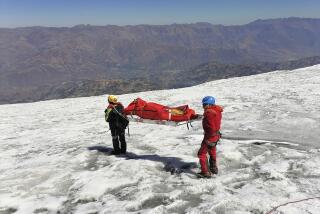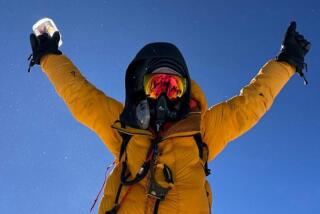Tenzing Norgay : Sherpa Who Led Hillary to Top Dies
- Share via
Tenzing Norgay, the slight Sherpa guide who helped vanquish the menacing peak of mankind’s greatest mountain, died Friday in the Himalayan mountain resort of Darjeeling in India’s West Bengal state.
He was believed to be 72 and died about 100 miles from the site of the triumph that propelled him from an illiterate tribesman into the palaces and state houses of the world.
Edmund Hillary, the beekeeper who stood atop Mt. Everest with Tenzing 33 years ago this month, called his old companion’s death “an unexpected shock.”
Sir Edmund, since knighted and now New Zealand’s ambassador to India, added that the former porter, who died of a chronic lung ailment, “had a remarkable life . . .” and “had a tremendous impact on society.”
“I feel he fulfilled his dreams,” he said.
Since May 29, 1953, when Sir Edmund and Tenzing--dubbed “The Tiger of the Snows”--conquered the 29,028-foot mountain, few could argue with Hillary’s assessment of Tenzing.
Humble Origins
Sir Edmund went from his mountaineering masterpiece to move amid the world’s diplomats. Tenzing, who because of his humble origins never went to school, was offered film roles and toured the world, lecturing to audiences that included royal families and world leaders.
It was a fame he found both rewarding and frustrating. Streets and villages in both his native land and elsewhere were named for him--a peasant born in Solokhumbu, Nepal, the 11th of 13th children.
There the family herded yaks in the shadow of the mountain the boy would one day conquer.
Tenzing, who was not even sure of the year he was born but thought it was 1914, worked as a porter for at least six earlier Everest expeditions (the number varied in the telling, but the first was in 1936) attempting to scale what the devout Buddhist Sherpas call “Goddess-Mother-of-the-World.”
Treacherous Slopes
Those experiences not only familiarized him with the treacherous slopes of Everest but enabled him to develop a smattering of French and English.
On two of those efforts, his teams had come within a few hundred feet of Everest’s crown, but weather and a lack of oxygen conspired to keep the expeditioners at bay.
(In 1924, George Leigh-Mallory and Andrew Irvine were seen through a telescope from base camp about 1,500 feet from the top. But the mists closed in, and that was the last ever seen of the British pair.)
It was the seventh and Tenzing’s final journey, sponsored and planned by Sir John Hunt--who selected Tenzing as Sir Edmund’s guide, because he was bigger (5 feet 8) and stronger than most of the other Sherpas--that brought two men from completely disparate backgrounds to the common pinnacle of the Earth.
Aimed for the Top
Hunt said Tenzing was “different from most Sherpas, because he wanted to get to the top of the mountain.”
“The others were quite happy to carry the loads,” he said.
Tenzing’s triumph brought him a chest full of medals, including Britain’s George Cross from Queen Elizabeth and the Star of Nepal from King Tribhuvan and the personal friendship of Jawaharlal Nehru, the late Indian prime minister.
Nepal and India each claimed him as its own. Crowds would chant his name as he walked through Darjeeling, and he once complained that fame had proved to be such a nuisance that he had to put a dog at the doorstep to the hillside home he shared with his wife and six children to keep people away.
It was Nehru, Tenzing said, who discouraged him from capitalizing further on his fame, and with the government’s help, he spent his final years teaching and inspiring other climbers through the Himalayan Mountaineering Institute.
Never Duplicated
And he was never tempted to try to duplicate his success, saying “There’s no point. . . . I’m not going to make it commercial.”
Generally he moved quietly and easily with his fame, telling journalists when he first fell ill with a lung infection last year that “it’s not because of the high altitude.”
“For me, I get sick at low altitudes,” he said.
The one question he disliked most and always refused to answer directly was who had first set foot atop Everest, himself or Hillary.
“This is teamwork, actually we climbed together,” he would tell questioners.
Written Account
However, his written account of that brilliant day when, even carrying oxygen both men found themselves out of breath, was more straightforward:
“A little below the summit Hillary and I stopped. We looked up. Then we went on . . . slowly . . . steadily. And then we were there. Hillary stepped on top first. And I stepped up after him.
“The sun was shining, and the sky was the deepest blue I have ever seen.”
Hillary took photographs. Tenzing sank to his knees and prayed.
More to Read
Sign up for Essential California
The most important California stories and recommendations in your inbox every morning.
You may occasionally receive promotional content from the Los Angeles Times.










